Papers by Roberto Cattaneo
Journal of Virology, Jun 1, 2008
Journal of Biological Chemistry, Aug 1, 1997
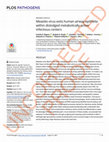
PLOS Pathogens, Aug 12, 2021
Measles virus (MeV) is the most contagious human virus. Unlike most respiratory viruses, MeV does... more Measles virus (MeV) is the most contagious human virus. Unlike most respiratory viruses, MeV does not directly infect epithelial cells upon entry in a new host. MeV traverses the epithelium within immune cells that carry it to lymphatic organs where amplification occurs. Infected immune cells then synchronously deliver large amounts of virus to the airways. However, our understanding of MeV replication in airway epithelia is limited. To model it, we use well-differentiated primary cultures of human airway epithelial cells (HAE) from lung donors. In HAE, MeV spreads directly cell-to-cell forming infectious centers that grow for 3-5 days, are stable for a few days, and then disappear. Transepithelial electrical resistance remains intact during the entire course of HAE infection, thus we hypothesized that MeV infectious centers may dislodge while epithelial function is preserved. After documenting by confocal microscopy that infectious centers progressively detach from HAE, we recovered apical washes and separated cell-associated from cell-free virus by centrifugation. Virus titers were about 10 times higher in the cell-associated fraction than in the supernatant. In dislodged infectious centers, ciliary beating persisted, and apoptotic markers were not readily detected, suggesting that they retain functional metabolism. Cell-associated MeV infected primary human monocyte-derived macrophages, which models the first stage of infection in a new host. Single-cell RNA sequencing identified wound healing, cell growth, and cell differentiation as biological processes relevant for infectious center dislodging. 5-ethynyl-2'-deoxyuridine (EdU) staining located proliferating cells underneath infectious centers. Thus, cells located below infectious centers divide and differentiate to repair the dislodged infected epithelial patch. As an extension of these studies, we postulate that expulsion of infectious centers through coughing and sneezing could contribute to MeV's strikingly high reproductive number by allowing the virus to survive longer in the environment and by delivering a high infectious dose to the next host.

Virology, Sep 1, 2013
The measles virus (MV) phosphoprotein (P) and V proteins block the interferon (IFN) response by i... more The measles virus (MV) phosphoprotein (P) and V proteins block the interferon (IFN) response by impeding phosphorylation of the signal transducer and activator of transcription 1 (STAT1) by the Janus kinase 1 (JAK1). We characterized how STAT1 mutants interact with P and JAK1 phosphorylation. Certain mutants of the linker, the Src-homology 2 domain (SH2), or the transactivation domain had reduced or abolished phosphorylation through JAK1 after IFN treatment. Other mutants, mainly localized in the linker, failed to interact with P as documented by the lack of interference with nuclear translocation. Thus the functional footprint of P on STAT1 localizes mainly to the linker domain; there is also some overlap with the STAT1 phosphorylation functional footprint on the SH2 domain. Based on these observations, we discuss how the MV-P might operate to inhibit the JAK/STAT pathway.
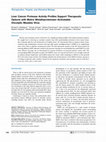
Cancer Research, Sep 29, 2010
Primary and secondary cancers of the liver are a significant health problem with limited treatmen... more Primary and secondary cancers of the liver are a significant health problem with limited treatment options. We sought here to develop an oncolytic measles virus (MV) preferentially activated in liver tumor tissue, thus reducing infection and destruction of healthy tissue. We documented that in primary tumor tissue, urokinase-type plasminogen activator and especially matrix metallproteinase-2 (MMP-2) are significantly more active than in adjacent nontumorous tissue. We then generated variants of the MV fusion protein by inserting different MMP substrate motifs at the protease cleavage site and identified the motif PQGLYA as the most efficient cleavage site as determined by syncytia formation on protease-positive tumor cells. The corresponding MMP-activatable oncolytic MV-MMPA1 virus was rescued and shown to be strongly restricted on primary human hepatocytes and healthy human liver tissue, while remaining as effective as the parental MV in the tumor tissue sections. Our findings underline the clinical potency of the MMP activation concept as a strategy to generate safer oncolytic viruses for the treatment of primary and secondary cancers of the liver.
Current Topics in Microbiology and Immunology, 1992
The molecular biology of measles virus (MV) and of other nonsegmented negative strand RNA viruses... more The molecular biology of measles virus (MV) and of other nonsegmented negative strand RNA viruses is currently subject to intense scrutiny for several reasons. First, acute MV infection is among the primary causes of infant death in third world countries (Bloom 1989). Second, on rare occasions, MV persistence induces lethal syndromes of the central nervous system known as subacute sclerosing panencephalitis (SSPE) and measles inclusion body encephalitis (MIBE) (reviewed in Ter Meulen et al. 1983). Third, unexpected phenomena such as biased hypermutation and RNA editing recently have been described for these viruses (reviewed in Billeter and Cattaneo 1991; Cattaneo 1990).
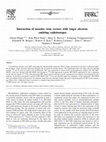
Biochemical and Biophysical Research Communications, Nov 1, 2005
A recombinant measles virus (MV) expressing the sodium iodide symporter (NIS) is being considered... more A recombinant measles virus (MV) expressing the sodium iodide symporter (NIS) is being considered for therapy of advanced multiple myeloma. Auger electrons selectively damage cells in which the isotope decays. We hypothesized that the Auger electron emitting isotope 125 I can be used to control viral proliferation. MV was engineered to express both carcinoembryonic antigen and NIS (MV-NICE). Cells were infected with MV-NICE and exposed to 125 I with appropriate controls. MV-NICE replication in vitro is inhibited by the selective uptake of 125 I by cells expressing NIS. Auger electron damage is partly mediated by free radicals and abrogated by glutathione. In myeloma xenografts, control of MV-NICE with 125 I was not possible under the conditions of the experiment. MV-NICE does not replicate faster in the presence of radiation. Auger electron emitting isotopes effectively stop propagation of MV vectors expressing NIS in vitro. Additional work is necessary to translate these observations in vivo.

Journal of Virology, Nov 15, 2008
The glycoprotein complex of paramyxoviruses mediates receptor binding and membrane fusion. In par... more The glycoprotein complex of paramyxoviruses mediates receptor binding and membrane fusion. In particular, the measles virus (MV) fusion (F) protein executes membrane fusion, after receptor binding by the hemagglutinin (H) protein. Structures and single amino acids influencing fusion function have been identified in the F-protein ectodomain and cytoplasmic tail, but not in its transmembrane (TM) region. Since this region influences function of the envelope proteins of other viruses, we examined its role in the MV F protein. Alanine-scanning mutagenesis revealed that an F protein with a single mutation of a central TM region leucine (L507A) was more fusogenic than the unmodified F protein while retaining similar kinetics of proteolytic processing. In contrast, substitution of residues located near the edges of the lipid bilayer reduced fusion activity. This was true not only when the mutated F proteins were coexpressed with H but also in the context of infections with recombinant viruses. Analysis of the H-F complexes with reduced fusion activities revealed that more precursor (F 0) than activated (F 1؉2) protein coprecipitated with H. In contrast, in complexes with enhanced fusion activity, including H-F L507A , the F 0 /F 1؉2 ratio shifted toward F 1؉2. Thus, fusion activity correlated with an active F-H protein complex, and the MV F protein TM region modulated availability of this complex.
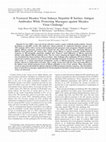
Journal of Virology, Oct 1, 2007
Hepatitis B virus (HBV) acute and chronic infections remain a major worldwide health problem. Tow... more Hepatitis B virus (HBV) acute and chronic infections remain a major worldwide health problem. Towards developing an anti-HBV vaccine with single-dose scheme potential, we engineered infectious measles virus (MV) genomic cDNAs with a vaccine strain background and expression vector properties. Hepatitis B surface antigen (HBsAg) expression cassettes were inserted into this cDNA and three MVs expressing HBsAg at different levels generated. All vectored MVs, which secrete HBsAg as subviral particles, elicited humoral responses in MV-susceptible genetically modified mice. However, small differences in HBsAg expression elicited vastly different HBsAg antibody levels. The two vectors inducing the highest HBsAg antibody levels were inoculated into rhesus monkeys (Macaca mulatta). After challenge with a pathogenic MV strain (Davis 87), control naive monkeys showed a classic measles rash and high viral loads. In contrast, all monkeys immunized with vaccine or a control nonvectored recombinant vaccine or HBsAg-expressing vectored MV remained healthy, with low or undetectable viral loads. After a single vaccine dose, only the vector expressing HBsAg at the highest levels elicited protective levels of HBsAg antibodies in two of four animals. These observations reveal an expression threshold for efficient induction of HBsAg humoral immune responses. This threshold is lower in mice than in macaques. Implications for the development of divalent vaccines based on live attenuated viruses are discussed.
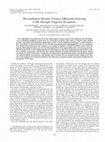
Journal of Virology, Nov 1, 2000
We sought proof of principle that one of the safest human vaccines, measles virus Edmonston B (MV... more We sought proof of principle that one of the safest human vaccines, measles virus Edmonston B (MV-Edm), can be genetically modified to allow entry via cell surface molecules other than its receptor CD46. Hybrid proteins consisting of the epidermal growth factor (EGF) or the insulin-like growth factor 1 (IGF1) linked to the extracellular (carboxyl) terminus of the MV-Edm attachment protein hemagglutinin (H) were produced. The standard H protein gene was replaced by one coding for H/EGF or H/IGF1 in cDNA copies of the MV genome. Recombinant viruses were rescued and replicated to titers approaching those of the parental strain. MV displaying EGF or IGF1 efficiently entered CD46-negative rodent cells expressing the human EGF or the IGF1 receptor, respectively, and the EGF virus caused extensive syncytium formation and cell death. Taking advantage of a factor Xa protease recognition site engineered in the hybrid H proteins, the displayed domain was cleaved off from virus particles, and specific entry in rodent cells was abrogated. These studies prove that MV can be engineered to selectively eliminate cells expressing a targeted receptor and provide insights into the mechanism of MV entry.
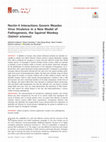
Journal of Virology, Jun 1, 2017
In addition to humans, only certain nonhuman primates are naturally susceptible to measles virus ... more In addition to humans, only certain nonhuman primates are naturally susceptible to measles virus (MeV) infection. Disease severity is species dependent, ranging from mild to moderate for macaques to severe and even lethal for certain New World monkey species. To investigate if squirrel monkeys (Saimiri sciureus), which are reported to develop a course of disease similar to humans, may be better suited than macaques for the identification of virulence determinants or the evaluation of therapeutics, we infected them with a green fluorescent protein-expressing MeV. Compared to cynomolgus macaques (Macaca fascicularis) infected with the same virus, the squirrel monkeys developed more-severe immunosuppression, higher viral load, and a broader range of clinical signs typical for measles. In contrast, infection with an MeV unable to interact with the epithelial receptor nectin-4, while causing immunosuppression, resulted in only a mild and transient rash and a short-lived elevation of the body temperature. Similar titers of the wild-type and nectin-4-blind MeV were detected in peripheral blood mononuclear cells and lymph node homogenates, but only the wild-type virus was found in tracheal lavage fluids and urine. Thus, our study demonstrates the importance of MeV interactions with nectin-4 for clinical disease in the new and better-performing S. sciureus model of measles pathogenesis. IMPORTANCE The characterization of mechanisms underlying measles virus clinical disease has been hampered by the lack of an animal model that reproduces the course of disease seen in human patients. Here, we report that infection of squirrel monkeys (Saimiri sciureus) fulfills these requirements. Comparative infection with wild-type and epithelial cell receptor-blind viruses demonstrated the importance of epithelial cell infection for clinical disease, highlighting the spread to epithelia as an attractive target for therapeutic strategies.
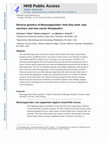
Virology, May 1, 2015
The order Mononegavirales includes five families: Bornaviridae, Filoviridae, Nyamaviridae, Paramy... more The order Mononegavirales includes five families: Bornaviridae, Filoviridae, Nyamaviridae, Paramyxoviridae, and Rhabdoviridae. The genome of these viruses is one molecule of negativesense single strand RNA coding for five to ten genes in a conserved order. The RNA is not infectious until packaged by the nucleocapsid protein and transcribed by the polymerase and cofactors. Reverse genetics approaches have answered fundamental questions about the biology of Mononegavirales. The lack of icosahedral symmetry and modular organization in the genome of these viruses has facilitated engineering of viruses expressing fluorescent proteins, and these fluorescent proteins have provided important insights about the molecular and cellular basis of tissue tropism and pathogenesis. Studies have assessed the relevance for virulence of different receptors and the interactions with cellular proteins governing the innate immune responses. Research has also analyzed the mechanisms of attenuation. Based on these findings, ongoing clinical trials are exploring new live attenuated vaccines and the use of viruses re-engineered as cancer therapeutics.

Journal of Virology, Aug 1, 2015
Defective interfering RNAs (DI-RNAs) of the viral genome can form during infections of negative-s... more Defective interfering RNAs (DI-RNAs) of the viral genome can form during infections of negative-strand RNA viruses and outgrow full-length viral genomes, thereby modulating the severity and duration of infection. Here we document the frequent de novo generation of copy-back DI-RNAs from independent rescue events both for a vaccine measles virus (vac2) and for a wildtype measles virus (IC323) as early as passage 1 after virus rescue. Moreover, vaccine and wild-type C-protein-deficient (C-protein-knockout [C KO ]) measles viruses generated about 10 times more DI-RNAs than parental virus, suggesting that C enhances the processivity of the viral polymerase. We obtained the nucleotide sequences of 65 individual DI-RNAs, identified breakpoints and reinitiation sites, and predicted their structural features. Several DI-RNAs possessed clusters of A-to-G or U-to-C transitions. Sequences flanking these mutation sites were characteristic of those favored by adenosine deaminase acting on RNA-1 (ADAR1), which catalyzes in double-stranded RNA the C-6 deamination of adenosine to produce inosine, which is recognized as guanosine, a process known as A-to-I RNA editing. In individual DI-RNAs the transitions were of the same type and occurred on both sides of the breakpoint. These patterns of mutations suggest that ADAR1 edits unencapsidated DI-RNAs that form doublestrand RNA structures. Encapsidated DI-RNAs were incorporated into virus particles, which reduced the infectivity of virus stocks. The C KO phenotype was dominant: DI-RNAs derived from vac2 with a C KO suppressed the replication of vac2, as shown by coinfections of interferon-incompetent lymphatic cells with viruses expressing different fluorescent reporter proteins. In contrast, coinfection with a C-protein-expressing virus did not counteract the suppressive phenotype of DI-RNAs. IMPORTANCE Recombinant measles viruses (MVs) are in clinical trials as cancer therapeutics and as vectored vaccines for HIV-AIDS and other infectious diseases. The efficacy of MV-based vectors depends on their replication proficiency and immune activation capacity. Here we document that copy-back defective interfering RNAs (DI-RNAs) are generated by recombinant vaccine and wild-type MVs immediately after rescue. The MV C protein interferes with DI-RNA generation and may enhance the processivity of the viral polymerase. We frequently detected clusters of A-to-G or U-to-C transitions and noted that sequences flanking individual mutations contain motifs favoring recognition by the adenosine deaminase acting on RNA-1 (ADAR1). The consistent type of transitions on the DI-RNAs indicates that these are direct substrates for editing by ADAR1. The ADAR1-mediated biased hypermutation events are consistent with the protein kinase R (PKR)-ADAR1 balancing model of innate immunity activation. We show by coinfection that the C-defective phenotype is dominant.
The EMBO Journal, Nov 1, 1991
Journal of Virology, 1991
Journal of General Virology, 2017
Viruses from the diverse family of Paramyxoviridae include important pathogens and are applied in... more Viruses from the diverse family of Paramyxoviridae include important pathogens and are applied in gene therapy and for cancer treatment. The Tupaia paramyxovirus (TPMV), isolated from the kidney of a tree shrew, does not infect human cells and neutralizing antibodies against other Paramyxoviridae do not cross-react with TPMV. Here, we present a vector system for de novo generation of infectious TPMV that allows for insertion of additional genes as well as targeting using antibody single-chain variable fragments. We show that the recombinant TPMV specifically infect cells expressing the targeted receptor and replicate in human cells. This vector system provides a valuable tool for both basic research and therapeutic applications.

Journal of Virology, 2011
Measles remains a leading cause of death worldwide among children because it suppresses immune fu... more Measles remains a leading cause of death worldwide among children because it suppresses immune function. The measles virus (MV) P gene encodes three proteins (P, V, and C) that interfere with innate immunity, controlling STAT1, STAT2, mda5, and perhaps other key regulators of immune function. We identified here three residues in the shared domain of the P and V proteins-tyrosine 110, valine 112, and histidine 115-that function to retain STAT1 in the cytoplasm and inhibit interferon transcription. This information was used to generate a recombinant measles virus unable to antagonize STAT1 function (STAT1-blind MV) differing only in these three residues from a wild-type strain of well-defined virulence. This virus was used to assess the relevance of P and V interactions with STAT1 for virulence in primates. When a group of six rhesus monkeys (Macaca mulatta) was inoculated intranasally with STAT1-blind MV, viremia was short-lived, and the skin rash and other clinical signs observed with wild-type MV were absent. The STAT1-blind virus less efficiently controlled the inflammatory response, as measured by enhanced transcription of interleukin-6 and tumor necrosis factor alpha in peripheral blood mononuclear cells from infected hosts. Importantly, neutralizing antibody titers and MV-specific T-cell responses were equivalent in hosts infected with either virus. These findings indicate that efficient MV interactions with STAT1 are required to sustain virulence in a natural host by controlling the inflammatory response against the virus. They also suggest that selectively STAT1-blind MV may have utility as vectors for targeted oncolysis and vaccination.
Molecular Therapy, Nov 1, 2013
Nature Reviews Microbiology, Dec 2, 2013
Early-stage clinical trials of oncolytic virotherapy have reported the safety of several virus pl... more Early-stage clinical trials of oncolytic virotherapy have reported the safety of several virus platforms, and viruses from three families have progressed to advanced efficacy trials. In addition, preclinical studies have established proof-of-principle for many new genetic engineering strategies. Thus, the virotherapy field now has available a diverse collection of viruses that are equipped to address unmet clinical needs owing to improved systemic administration, greater tumour specificity and enhanced oncolytic efficacy. The current key challenge for the field is to develop viruses that replicate with greater efficiency within tumours while achieving therapeutic synergy with currently available treatments.










Uploads
Papers by Roberto Cattaneo